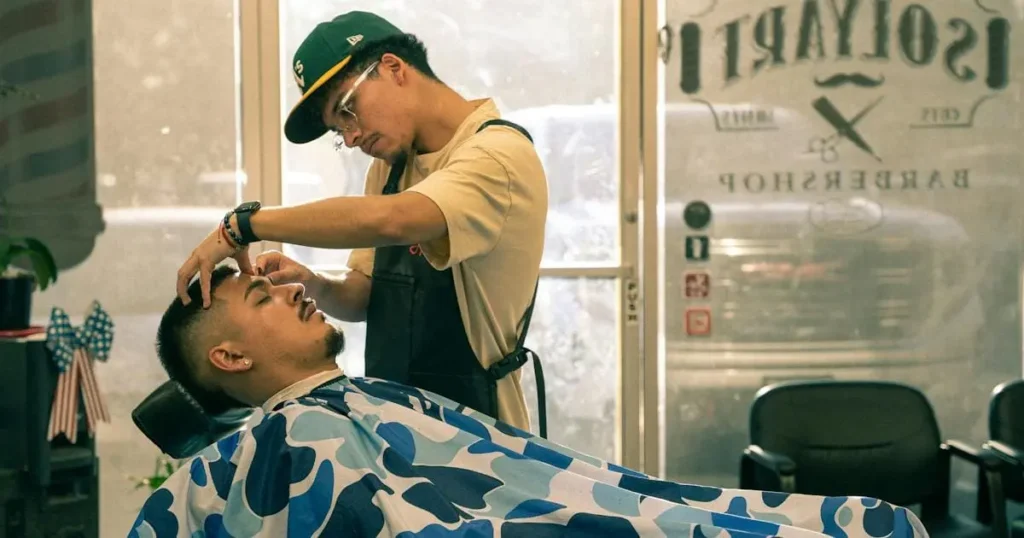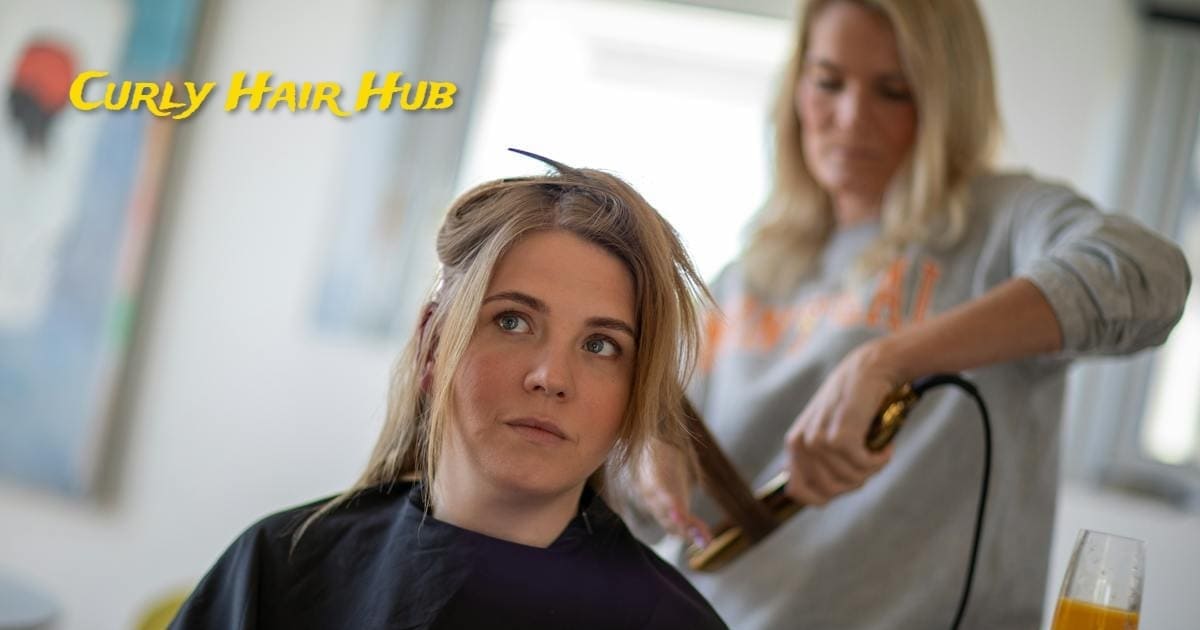Botox hair treatments have become an increasingly popular way to smooth frizz, add shine, and soften hair temporarily. But how long do the results actually last? Here’s a detailed look at what to expect in terms of longevity from a botox hair treatment.
Botox Hair Treatment:
Botox hair treatments are professional salon services that use a special formula to relax the bonds in the hair cuticle layers to smooth the hair shaft. The effect helps eliminate frizz temporarily, add shine, and make hair more manageable.
It does not contain the botulinum toxins used in anti-wrinkle injections for the face. The name relates more to the end result: hair that looks smoother, shinier, and healthier overall, like the effect of Botox on facial wrinkles.
How Is Botox Hair Treatment Applied?

A botox hair treatment process involves applying the formula evenly from roots to ends on shampooed, towel-dried hair, leaving it to penetrate the hair shaft for 10-15 minutes.
This is followed by blow drying and using a flat iron to “lock in” the effects. The entire process takes 2-3 hours from washing through styling. Treatments are done at salons approximately every 4-5 months since the effects wear off over time.
Benefits of Botox Hair Treatment:
| Smoothes hair cuticle layers | Reduces frizz up to 80% |
| Softens texture | Makes hair more manageable |
| Boosts shine | Safe for all hair types when done properly |
The smoothing effects can make hair look salon blow dried even after air drying naturally. For extremely curly, kinky, or frizzy hair types, a botox treatment can cut down styling time.
Botox Hair Treatment Lifespan:
The results of a single botox hair treatment typically last 16-20 weeks. For most people, the effects are very noticeable for about 12-16 weeks. In the last 4-6 weeks, there is some gradual fading and loss of smoothness/frizz control.
There can be variations in longevity depending on:
- Hair texture/curl pattern – Very curly or coily hair holds onto the smoothing effects a little longer than looser curl patterns or straight hair. The effects fade faster on straight or wavy hair.
- At-home care – Proper at-home care is crucial for maximizing longevity between sessions. Using sulfate-free shampoos and silicone-free conditioners, limiting heat styling, and using repairing hair masks are key for maintaining the results longer. Not properly caring for treated hair at home can shorten the longevity.
- Frequency of washing – Washing hair less frequently can extend the lasting effects versus washing daily. Focus on dry shampooing instead of full washes in between to make the botox last longer.
So the range is 16-20+ weeks depending on hair type and proper maintenance. Over time with repeat treatments, some people can stretch botox results up to 6 months. But in general expect smoothed, frizz-free hair for about 4 months give or take.
Wear-Off Consequences:
As the treatment fades after 12+ weeks, the bonds in the hair shaft begin to revert to their original structure. Hair will slowly lose its smoothness and start feeling “poofy”. Frizz and volume may increase.
It’s not a drastic change overnight, but a gradual return to the pre-treated hair texture. How fast the reversion happens depends on the above factors like hair type and aftercare. With proper maintenance, the process can be slower.
Does Botox Hair Get Damaged From Repeat Treatments?
When performed correctly by a trained professional, botox hair treatments do NOT damage hair even with repeated sessions. However, this answer comes with a few caveats:
- The formula needs to be high-quality and contain beneficial conditioning and repairing ingredients. Botulinum toxins should NOT be used.
- Proper technique is essential – applying evenly, not overlapping too much, thoroughly rinsing before heat styling. Improper application can increase chances of damage over time.
- Always get treatments done by an experienced, licensed stylist. Their skill impacts the safety and effectiveness long-term.
- Take good care of hair at home between sessions – use repairing masks, limit heat styling, etc.
Following those guidelines, botox can be done repeatedly without compromising hair health. But failing to follow best practices may increase the changes of breakage or drying long term. Exercise some caution finding the right provider.
In general, reputable hair stylists do not recommend at-home botox hair treatments even from popular brands. There are a few key reasons:
- Application Precision – Smooth, even application and leaving the product on for exact timed intervals is tricky to achieve consistently yourself at home. Missed spots or overlapping application risks damage over time. Professionals are skilled in precision application.
- Formulas – Most at home kits cannot replicate the salon formulas with patented complexes that safely seal cuticles rather than over-process the bonds. Some contain formaldehyde which should absolutely be avoided. Quality and safety varies widely.
- Sealing Process – Blow drying, flat ironing, and other heat techniques professionals use can be difficult to replicate consistently yourself at home to properly seal in the smoothing effects maximum duration.
- Diagnosing Hair Needs – An experienced stylist examines hair first to assess condition, texture, integrity and tailor the process accordingly. It’s not one-size-fits-all. At home it’s harder to determine your specific hair’s ideal treatment approach.
So while affordable and convenient compared to salon visits, most stylists would not recommend at home DIY botox kits as a substitute for professional treatments when it comes to safety, effectiveness and avoiding eventual hair damage from overlapping applications over time.
Will Results Be The Same Each Session?
Consistency between sessions depends mainly on adherence to proper procedures outlined above. When getting botox from the same trained stylist and properly maintaining hair at home between appointments, results should remain fairly similar each time.
Over a long series of treatments, the effects may start to last slightly longer as hair gets “trained” to hold onto smoothness with each repeated application. But in general expect reliable frizz reduction and smoothing for 4+ months when sticking with the same provider using a high-quality formula correctly.
If results seem to diminish noticeably session over session, it’s time to reassess home care routines or even consider switching stylists. But when performed correctly, botox hair can reliably smooth frizzy hair long term with no loss of results.
What About Keratin Treatments? How Do They Compare?

Keratin smoothing treatments are a close alternative to botox hair treatments offering similar frizz-smoothing results. The main differences compared to botox come down to:
Longevity:
Typical keratin treatments last closer to 3 months rather than the average 4+ month duration botox provides. Keratin results fade slightly faster for most. But keratin still offers a sizable improvement over non-treated hair.
Severity of Initial Effects:
Botox tends to have a more dramatically smoothed effect for the first couple weeks post-treatment since it more aggressively seals the cuticle layers initially. Keratin closing the cuticle is a bit milder. But final longevity is ultimately a bit better with botox.
Safety:
Some keratin treatment formulas contained formaldehyde previously raising health concerns. Most reputable brands now use safer formulations. But checks for formaldehyde-free labels and proper ventilaion at salons should still be considered. Botox formulas tend to have less safety objections overall when done properly.
So botox vs keratin comes down personal preference based on these factors. Both offer substantially improved smoothness and frizz control. But botox creates a slightly more glass-like look for the first month or two in exchange for some added longevity of results. Keratin is likely the safer choice for fine or damaged hair that would react poorly to aggressive initial sealing.
What Products Help Maintain Botox Smoothness Between Salon Visits?
The right at-home products are critical for maximizing botox and keratin treatment longevity. Using overly detergent-heavy shampoos can strip the hair cuticle, accelerating fade out. Silicones also prevent deeper conditioning.
Some keys for self-care between professional smoothing sessions include:
- Sulfate-free shampoos – Less harsh cleansing preserves seals on hair cuticles longer. Sulfate-free is gentler.
- Weekly repair masks – Deep conditioning restores moisture as overlapping processes can dry out hair over time.
- Heat protectants – Crucial for limiting styling damage between treatments to maintain integrity.
- Dry shampoo – Extend wash frequency to avoid sulfate exposure and loss of smoothness.
So read all product labels thoroughly and adjust routines between salon visits to use only formulas that prolong seals rather than strips them prematurely. Consult your stylist for their recommendations too.
How Does Botox Compare To Straightening Treatments For Very Curly Hair?
For very tightly coiled 4C curls, mega-curly 3C hair, or persistent frizz in humidity, botox alone might not fully straighten or overcome texture. In those cases, keratin or botox smooth curls slightly but a relaxer or Japanese thermal reconditioning are stronger alternatives.
However, those processes don’t just reduce frizz – they permanently rearrange curl pattern for totally straight hair. That takes an intensive chemical process with higher risks like:
- Overprocessing damage
- Loss of elasticity long-term
- Excessive dryness or breakage
So while a relaxer or Japanese straightening can fully defeat coils, curls, or frizz for 12+ weeks, they are too intense for many. The risks outweigh the rewards for moderately curly or wavy hair just seeking smoother texture with some curl intact.
For lasting super-straight hair, a relaxer or Japanese straightening service permanently breaks bonds responsible for curl pattern. Botox is the far gentler alternative for slight improvement on curl manageability while maintaining some coil integrity. Assess personal priorities for long term hair texture and curl preferences when weighing those options.
Can Botox Treatments Add Volume or Body?
While botox is primarily used to smooth and loosen curls, some formulas claim secondary “body building” effects adding fullness or thickness during application. However, reviews on actual boosting ability are mixed.
There are a couple factors influencing botox treatments for potential volumizing perks:
- Hair density – Those with *extremely thick hairtexture may not observe increased fullness from botox treatments as density already maxes out volume capacity from the scalp outward. Where thinning, baby fine hair could realize some thickening effects.
- Formulas – Some botox treatments explicitly integrate plumping or thickening agents like collagen, biotin, keratin proteins. But not all do. So formulas designed for added body claims may be prerequisites for realizing any volumizing advantage. Standard smoothing botox alone likely doesn’t boost fullness for most.
Overall, expect only moderate secondary volume boosting potential from a thickening botox hair treatment even when explicitly formulated for body building claims. For thinning hair, results may prove more noticeable however. But managing limpness or flat hair still requires diligent styling moreso than relying on botox solely.
How Much Does Botox Hair Treatment Cost On Average?
Given the intensive process requiring special materials, trained technicians and 2-3 hours at the salon, professional botox hair treatments range from $150 on the very low end to upwards of $600-700 for premier colour correction services from top level stylists.
More typical prices the average client can expect are:
- Basic Botox – $200-400
- Botox + Haircut – $250-450
- Botox + Full Colour – $325-525
So most clients invest around $300 per service for standard smoothing with ancillary styling or colour. Understandably cost prohibits some. But when tallying up budgets, remember to consider:
- Number of expected washes/styles during 4 months between bookings
- Cost per year over lifelongcolour/cuts anyway
- Value of decades of hair health over damage from overlapping DIY kits
Factoring those angles, professional botox costs save money long run through offsetting overlapping cuts/colours plus avoiding eventual damage controlling treatments. So an expensive endeavour, but pays dividends when properly maintaining integrity between well-spaced salon sessions.
Can Botox Treatments Cause Hair Loss Over Time?

In very rare cases, some people undergoing serial botox treatments long term experience thinning around the frontal hairline years down the road.
However blaming botox solely ignores other factors almost always in play when hair loss issues emerge, including:
- Genetic predispositions
- Accumulated sun damage
- Stressors
- Pregnancies/childbirth (for women)
- Nutrient deficiencies
Additionally, assuming the weakening happened due to the botox alone fails to consider application errors that potentially caused breakage instead. As outlined initially, overlapping applications or improper formulations raise damage risks necessitating eventual trims.
So while not impossible for repeat procedures to exacerbate genetic hair loss minimally over time, botox alone performed correctly cannot physiologically trigger baldness where no prior thinning tendencies exist.
Always consult stylists routinely for assessments ensuring treatments progress properly long term without signs of trouble. Adjust approaches early when necessary by troubleshooting home care issues, trying protective supplements, spacing out bookings further if recommended, etc. Stay vigilant rather than risk years of overlapping damage potentially speeding up pre-existing loss.
Conclusion
In conclusion, the duration of the effectiveness of Botox hair treatments is a common concern for those considering this salon service. While individual experiences may vary, the general consensus is that the effects are temporary, providing a temporary solution to concerns like frizz, lack of shine, and manageability.
On average, the results can last several weeks, making it a popular choice for those seeking a temporary transformation without a long-term commitment. As always, it’s essential to consult with a professional stylist to understand the specific factors that may influence the longevity of the treatment and to tailor the approach to individual hair needs.
Whether preparing for a special occasion or simply desiring a change, the temporary nature of Botox hair treatments offers a flexible and customizable option for those looking to enhance the health and appearance of their hair.
Common Questions About Botox Hair Treatments
Curious about the ins and outs of Botox hair treatments? Here’s a common question many people ask:
How long does a botox treatment take at the salon?
A single botox hair treatment session takes approximately 2-3 hours from start to finish. This includes the initial shampoo, roughly 15 minutes for application and processing time, blow drying or flat ironing to seal in the effects, and a quick trim or other finishing styling. Total appointment time ranges from 2-3 hours.
Can botox straighten African American hair?
Yes, when performed properly by an experienced stylist, botox hair treatments are safe and effective for straightening and smoothing highly textured African American hair types. The results may not fully straighten extremely kinky or coily hair completely. But botox can significantly relax curl patterns and reduce frizz/volume for easier management and styling versatility whether wearing hair straight or curly. Proper home care is especially crucial for maintaining results in highly textured hair between salon sessions.
Is botox good or bad for hair?
Professional botox hair treatments are beneficial for hair health when using reputable formulas and proper techniques. The top products utilize reparative proteins, conditioning agents, antioxidants and vitamins to protect hair during the process. When applied correctly to avoid overlap or overprocessing, botox can safely relax texture and frizz without compromising hair or creating damage over time. At-home care also impacts overall hair health between treatments. Using caution in finding an experienced provider is key, but reputable salon botox treatments can effectively improve hair manageability without risk to long term health and integrity when performed properly.
Can botox be done at home or is salon recommended?
It is strongly recommended to only get professional botox hair treatments done at a licensed salon by a well trained stylist. At-home botox kits lack the complexes to seal the hair cuticle and may use ingredients that compromise hair health over time. Professionals also have the proper tools and heat techniques to maximize results. Salon treatments ensure proper application and precision to avoid overlapping and uneven results which can increase chances of damage when doing multiple treatments. Leave it to the experts for safest, most consistent results.
How often can you get botox hair treatments done?
Most people get professional botox hair treatments touched up every 4-5 months as this is the average duration for maximum smoothing results on most hair types. However some factors like very curly hair, less frequent hair washing, using properly reparative aftercare products, and avoiding heat styling between sessions can potentially stretch the longevity closer to 5-6 months before a follow up is needed. Back-to-back treatments at shorter intervals are not recommended. Always consult your stylist and assess your specific hair needs, but plan for repeat botox sessions roughly every 4-5 months for reliable, repeated smoothing.
